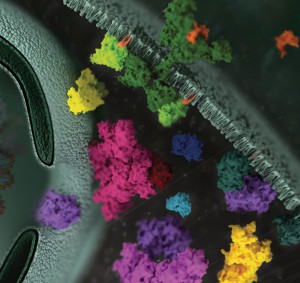 In a recent reference, Kinoshita and colleagues characterized the phosphorylation dynamics of MEK1 in human cells by using the phosphate affinity electrophoresis technique, Phos-tag sodium dodecyl sulfate–polyacrylamide gel electrophoresis (Phos-tag SDS-PAGE; 1). They found that multiple variants of MEK1 with diferent phosphorylation states are constitutively present in typical human cells.
In a recent reference, Kinoshita and colleagues characterized the phosphorylation dynamics of MEK1 in human cells by using the phosphate affinity electrophoresis technique, Phos-tag sodium dodecyl sulfate–polyacrylamide gel electrophoresis (Phos-tag SDS-PAGE; 1). They found that multiple variants of MEK1 with diferent phosphorylation states are constitutively present in typical human cells.
To investigate the relationships between kinase activity and drug efficacy researchers from the same laboratory group conducted phosphorylation profling of various MEK1 mutants by using Phos-tag SDS- PAGE (2).
They introduced mutations in of the MEK-1 coding gene that are associated with spontaneous melanoma, lung cancer, gastric cancer, colon cancer and ovarian cancer were introduced into Flexi HaloTag clone pFN21AE0668, which is suitable for expression of N-terminal HaloTag-fused MEK1 in mammalian cells. Phos-tag SDS-PAGE was used to separate the wildtype protein from the proteins produced from the mutant sequences. Using immunoblotting with anti-pMEK1/2 to detect active species of MEK, Kinoshita-Kikuta were able to determine whether or not each introduced mutation contributed to an activate MEK.
To validate the results of the Phos-tag and immunoblotting experiments, MEK1 Kinase activity measurements were made by pulldown of Halotag fused proteins using Magne HaloTag beads and incubating in the presence of APT and inactive ERK1. Wildtype and MEK species containing mutations not predicted to be associated with activated MEK, produced little or no detectable phosphorylation of ERK. However, mutations that were determined to be active by the Phos-tag analysis did show significant phosphorylation of the ERK target.
The authors conclude that the banding patterns of the in Phos-tag SDS-PAGE provide critical information about the kinase activities of MEK1 mutants. This Phos-tag-based strategy may be useful for screening the phosphorylation of regulatory factors in drug discovery.
Literature Cited
- Kinoshita, E. et al. (2016) A Phos‐tag SDS‐PAGE method that effectively uses phosphoproteomic data for profiling the phosphorylation dynamics of MEK1. Proteomics 16, 1825–36.
- Kinoshita-Kikuta, E. etal. (2019) Increase in constitutively active MEK1 species by introduction of MEK1mutations identified in cancers. Proteins and Proteomics 1867, 62-70
Want to learn more about HaloTag?
See what you can do with HaloTag® fusion proteins.
